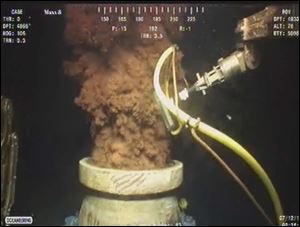
BP adopts new safety standards for deepwater drilling in the Gulf of Mexico after spill
7/15/2011
Oil flows out of the top of the transition spool, which was placed into the gushing wellhead and will house the new containment cap, at the site of the Deepwater Horizon oil spill in the Gulf of Mexico, in this July 12, 2010, image from video made available by BP PLC.
ATLANTA — A year after it capped its out-of-control well in the Gulf of Mexico, oil giant BP PLC said Friday it is taking new steps to improve the reliability of the cement used to seal its wells and the fail-safe devices used to prevent blowouts.
The U.S. government welcomed the voluntary measures announced by the British firm — which seemed to target shortcomings addressed in several investigations of the disaster — but also noted that it has already established what it believes are strong safety and environmental standards that all operators are required to meet in order to operate in deep waters.
Eleven men were killed when the Deepwater Horizon rig exploded off Louisiana on April 20, 2010, leading to the worst offshore oil spill in U.S. history. The well was capped on July 15, 2010, and permanently sealed from the bottom two months after that. The government estimates that some 206 million gallons of oil were released by BP's Macondo well a mile beneath the sea. Tens of billions of dollars have been spent or committed by BP on cleaning up the devastation and compensating victims.
PHOTO GALLERY: One-year anniversary of disaster
BP said that with regard to its drilling operations in the Gulf in the future it will:
- Require that one of its engineers or an independent third-party monitor conduct lab testing of the cement used to seal its deepwater wells. It will provide the results to government officials.
- Require extra precautions be taken with blowout preventers used on rigs it leases to drill its wells. The measures involve using blowout preventers with extra shearing devices that would cut through drill pipe and seal a well in the event of a mishap.
- Include in its oil spill response plan information about enhanced response measures based on lessons learned from the Deepwater Horizon disaster.
The cement and blowout preventer used with BP's well and the oil spill response plan it employed during the disaster all came under fire in numerous investigations of the disaster by the government, Congress and the companies involved.
New drilling rules have been imposed, a high-tech system for capping a blown-out well and containing the oil has been built, and regulators have taken steps to ramp up oversight of the industry.
But industry experts have said that despite the extra measures taken by government and industry since the Deepwater Horizon explosion, they believe another disaster could happen again.
They have noted that the effectiveness of the much-touted containment system has been questioned, and a design flaw in the blowout preventers widely used across the industry has been identified but not corrected.
In Washington, U.S. Rep. Edward Markey, a Massachusetts Democrat and ranking member of the House Committee on Natural Resources, said that if BP can adopt voluntary safety standards that go above what is required by regulators, the rest of the oil and gas industry can, too.